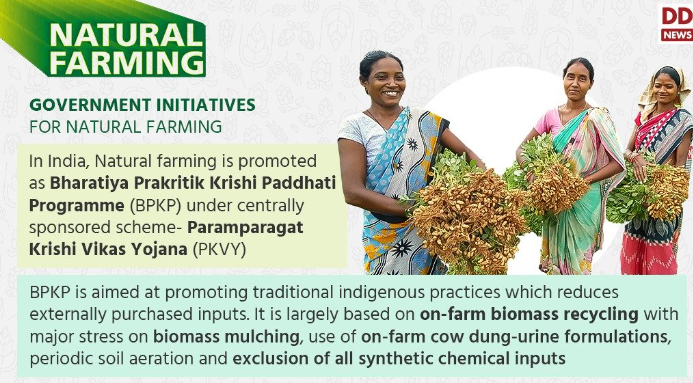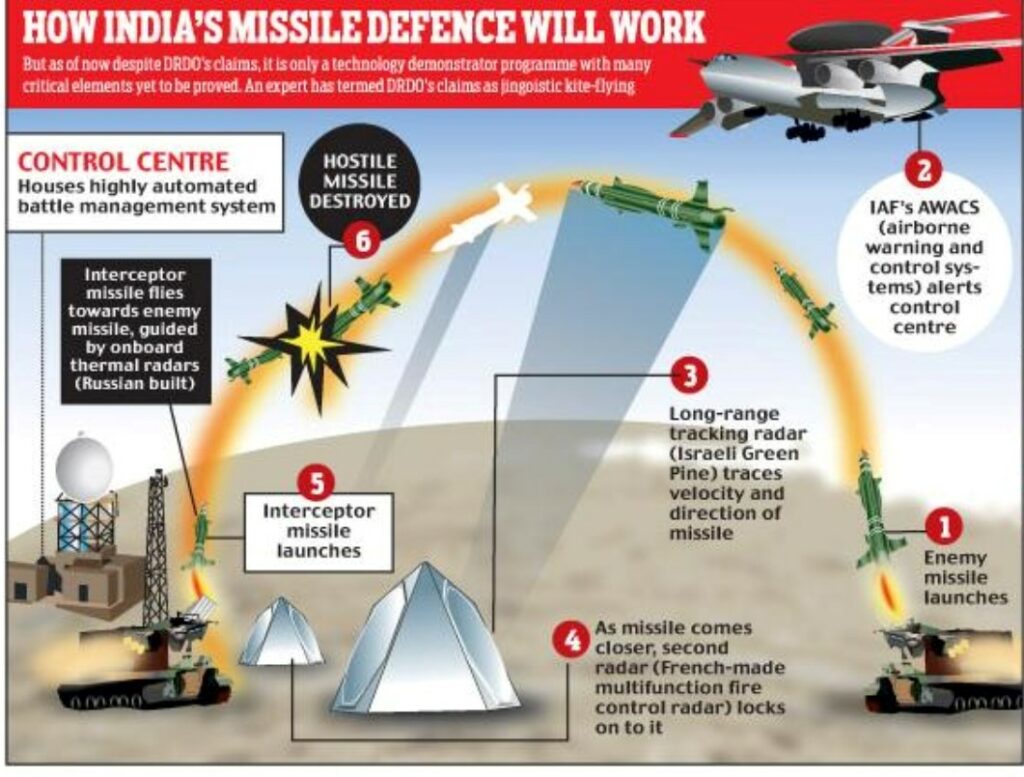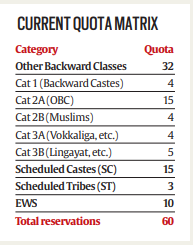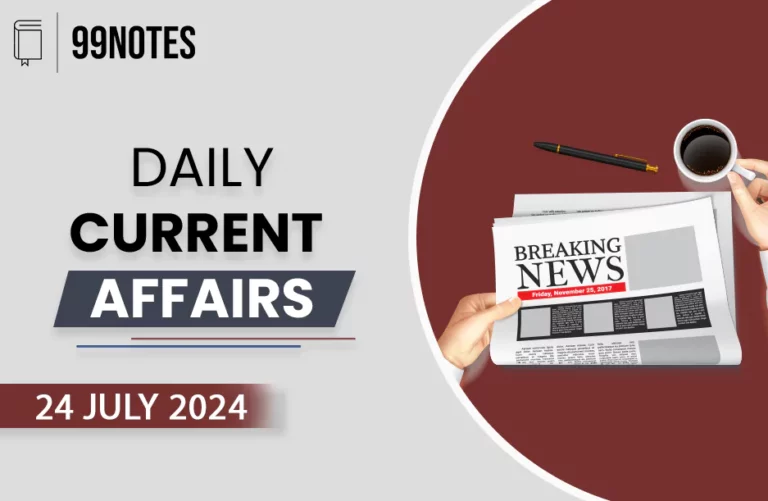25 July 2024 : Daily Current Affairs
1. India committed to FTA with the U.K., says Modi
(Source – The Hindu, International Edition – Page No. – 4)
| Topic: GS2 – International Relations – Bilateral Relations |
| Context |
|
India’s Commitment:
- Prime Minister Narendra Modi reaffirmed India’s commitment to concluding a Free Trade Agreement (FTA) with the United Kingdom.
- The announcement followed a meeting with David Lammy, the UK Secretary of State for Foreign, Commonwealth and Development Affairs.
High-Level Visit:
- David Lammy is the highest-ranking UK official to visit India since the recent Labour government’s victory.
- The visit highlights the UK’s focus on strengthening ties with India and advancing the Comprehensive Strategic Partnership.
Bilateral Discussions:
- During the visit, Lammy was hosted by India’s External Affairs Minister, S. Jaishankar, for discussions on a range of issues.
- Jaishankar emphasised the importance of cooperation on global matters and platforms, including climate action.
Technological and Economic Cooperation:
- Both leaders welcomed the bilateral Technology Security Initiative, aiming to enhance technology-related collaboration.
- The focus is on creating opportunities for both British and Indian businesses as part of the broader FTA discussions.
Focus on Global Platforms:
- Jaishankar highlighted the significance of India and the UK working together on global issues, leveraging their significant global presence.
- This collaboration extends to addressing challenges like climate change on international platforms.
Statements by David Lammy:
- Lammy referred to the “unique living bridge” between India and the UK and emphasised building on climate action and economic opportunities.
- He noted that India is a key player on the global stage, being an emerging superpower with rapid economic growth and the world’s largest population.
Strategic Reconnection:
- Lammy’s visit aims to reset the UK’s relationship with the Global South, positioning Britain for enhanced security and prosperity.
- The FTA discussions have been ongoing for several years, reflecting the complexity and protracted nature of the negotiations.
| Potential significance of India – UK FTA: |
|
| Practice Question: Discuss the potential significance and challenges of finalising a Free Trade Agreement between India and the United Kingdom. (250 Words /15 marks) |
2. No progress on UN Security Council expansion, say former Ambassadors
(Source – The Hindu, International Edition – Page No. – 4)
| Topic: GS2 – International Relations |
| Context |
|
Lack of Progress on UNSC Reform:
No Concrete Progress:
- Despite continuous efforts, there has been “no progress” on the reform and expansion of the United Nations Security Council (UNSC).
- India and other countries, notably the G-4 (Brazil, Germany, Japan), continue to push for permanent seats but face stagnation in the reform process.
Frustration Ahead of Summit of the Future:
- The lack of advancement is causing frustration, particularly ahead of the UN’s Summit of the Future scheduled for September 22-23.
- Over 150 world leaders are expected to attend to discuss plans to “reboot” the UN.
- The G-4 countries, advocating for permanent UNSC seats, have expressed dissatisfaction with the proposed “Pact of the Future” to be released during the summit.
Statements from Former Indian Diplomats:
- Ruchira Khamboj, India’s former Permanent Representative to the UN (2022-2024), highlighted the stagnation in reform efforts.
- While there has been movement in making the Intergovernmental Negotiations (IGN) process more transparent, such as live broadcasts and digital repositories for proposals, real progress on UNSC expansion remains absent.
Current UNSC Composition Criticised:
- India’s Acting Permanent Representative R. Ravindra criticised the UNSC’s outdated structure during a recent UNSC debate.
- He noted the Council’s composition, dominated by the five permanent members (P5) who are considered the victors of World War II, fails to reflect modern geopolitical realities.
Disillusionment and Alternatives:
- Disillusionment with the current multilateral system is leading member states to explore various alternatives, questioning the effectiveness of the existing UNSC structure.
| United Nation Security Council: |
|
| Practice Question: Examine the need for reforming the United Nations Security Council (UNSC) in the context of contemporary global challenges. (150 Words /10 marks) |
3. Is immunity for the President and Governors absolute?
(Source – The Hindu, International Edition – Page No. – 10)
| Topic: GS2 – Indian Polity |
| Context |
|
Analysis of the news:
- Judicial Bench and Petition:
- A three-judge Bench led by Chief Justice of India D.Y. Chandrachud is examining a petition concerning the immunity granted to Presidents and Governors under Article 361.
- The case involves a contractual woman employee of the Raj Bhavan who has accused West Bengal Governor C.V. Ananda Bose of sexual harassment and molestation.
- Petitioner’s Claims:
-
- The woman, referred to as ‘XXX’ to protect her identity, argues that the “absolute immunity” provided to Governors under Article 361 is based on an outdated principle that the “King can do no wrong.”
-
- She contends that this immunity has led to her complaint being treated with disregard by the police, as they cite the immunity clause.
-
- She fears that the delay in investigation due to the Governor’s immunity may ultimately deny her justice.
- The petitioner seeks a court mandate for the State of West Bengal to conduct an investigation and requests the Supreme Court to frame guidelines on the extent of this immunity.
-
Article 361 and Immunity Provisions
- Article 361 Overview:
- Clause (1): Provides that the President and Governors are not answerable to any court for acts performed in their official capacity.
- First Proviso: Allows for the President’s conduct to be reviewed by a designated court or body for impeachment proceedings under Article 61.
- Second Proviso: Immunity does not prevent suing the Centre or State concerned.
- Clause (2) in Focus:
- Specifies that “no criminal proceedings whatsoever shall be instituted or continued against the President, or the Governor of a State, in any court during his term of office.”
- The Supreme Court is set to interpret this clause to determine whether the immunity is “unfettered or unbridled.”
Constitutional Debate and Historical Context
- Constituent Assembly Debate:
- In September 1949, debates on Article 361 (Draft Article 302) raised concerns about the vagueness of the phrase “during the term of his office.”
- A query was made about whether a President or Governor could evade accountability by remaining in office despite committing a criminal act.
- This question was left unresolved at the time.
Arguments and Interpretations
- Petitioner’s Arguments:
- The petitioner argues that the immunity under Article 361(2) should not extend to acts that violate fundamental rights or are illegal.
- The alleged misconduct of Governor Bose infringes upon her fundamental right to life under Article 21 of the Constitution.
- The petitioner asserts that Article 361 immunity should not obstruct the police from investigating the offence or naming the perpetrator in an FIR.
- The immunity does not sanction illegal acts such as sexual abuse.
- Precedents and Analogies:
- Rameshwar Prasad vs. Union of India: Interpreted that ‘civil immunity’ under Article 361(4) does not preclude citizens from challenging the President or Governors on grounds of mala fides.
- Ram Naresh vs. State of Madhya Pradesh: Madhya Pradesh High Court ruled that immunity does not prevent the police from investigating an offence or recording statements, including those of the Governor.
Conclusion
- The Supreme Court’s interpretation of Article 361(2) will be crucial in determining the limits of immunity granted to the President and Governors.
- The court’s decision will address whether such immunity undermines fairness, constitutional morality, and fundamental rights to equal protection and fair trial.
| Practice Question: Examine the implications of Article 361 of the Indian Constitution on the accountability of Presidents and Governors in cases of alleged criminal misconduct. Discuss the potential impact of its interpretation on fundamental rights and the fairness of the legal process. (250 Words /15 marks) |
4. TRANSFORMING AGRICULTURE: GOVERNMENT’S HOLISTIC STRATEGY FOR PRODUCTIVITY AND RESILIENCE
(Source – https://pib.gov.in/PressReleseDetail.aspx?PRID=2036417 )
| Topic: GS3 – Indian Economy – Agriculture |
| Context |
|
Natural Farming Initiative:

- Objective: Train 1 crore farmers in natural farming to boost sustainability and productivity while enabling access to premium markets.
- Definition: Natural Farming is a chemical-free, livestock-based farming system that integrates crops, trees, and livestock. It aims to enhance farmers’ income, restore soil fertility, and reduce greenhouse gas emissions.
- Implementation: Bharatiya Prakritik Krishi Paddhati (BPKP) under the Paramparagat Krishi Vikas Yojana (PKVY) promotes indigenous practices with an allocation of Rs 4645.69 crore for 2019-20 to 2024-25.
Self-Sufficiency in Pulses and Oilseeds:
- National Food Security Mission – Oilseeds (NFSM-OS): Aims to increase oilseed production and reduce import dependency. Oilseed production reached 41.4 million tonnes in 2022-23, reducing the share of imported edible oil.
- Minimum Support Price (MSP): Increased MSPs for pulses and oilseeds for 2024-25 to ensure economic viability and sustainability for farmers.
High-Yielding and Climate-Resilient Varieties:
- Initiative: Introduction of 109 new high-yielding and climate-resilient crop varieties across 32 crops.
- Achievements: From 2014-15 to 2023-24, 2593 high-yielding varieties, including 2177 climate-resilient varieties, were released. Deployment of these technologies has led to increased production even during adverse conditions.
Digital Public Infrastructure (DPI) in Agriculture:
- Objective: Enhance agricultural efficiency through digital technology. Initial phase includes a digital crop survey in 400 districts to collect data on crop patterns, land use, and yields.
- Impact: Aims to improve precision in planning and implementing agricultural strategies, including subsidy distribution and disaster management.
Jan Samarth Initiative: Kisan Credit Cards (KCC):
- Objective: Simplify access to credit for farmers through Kisan Credit Cards. As of January 31, 2024, 7.5 crore KCCs have been issued with a limit of ₹9.4 lakh crores.
- Extension: KCCs were extended to support fisheries and animal husbandry, with limits increased for collateral-free loans.
Strengthening Shrimp Industry:
- Objective: Enhance shrimp breeding and financial support through NABARD. The establishment of Nucleus Breeding Centres (NBCs) will improve the quality and productivity of shrimp brood stocks.
- Impact: India is a major shrimp producer and exporter, with shrimp exports growing to Rs 40,013 crore in 2023-24.
Conclusion:
- The Indian government’s strategy to enhance agricultural productivity and resilience includes natural farming, self-sufficiency in pulses and oilseeds, development of climate-resilient crop varieties, implementation of Digital Public Infrastructure, and support for the shrimp industry.
- These initiatives aim to modernise agriculture and ensure sustainable growth across the sector.
| PYQ: Given the vulnerability of Indian agriculture to vagaries of nature, discuss the need for crop insurance and bring out the salient features of the Pradhan Mantri Fasal Bima Yojana (PMFBY) (200 words/12.5m) (UPSC CSE (M) GS-3 2016) |
| Practice Question: Discuss the Indian government’s strategy to enhance agricultural productivity and resilience. How do initiatives like natural farming, Digital Public Infrastructure, and support for shrimp breeding contribute to this goal? (250 Words /15 marks) |
5. National Cooperative Policy
(Source – https://pib.gov.in/PressReleseDetail.aspx?PRID=2036425 )
| Topic: GS2 – Governance |
| Context |
|
Formation of the National Level Committee
- A 48-member National Level Committee, chaired by Shri Suresh Prabhakar Prabhu, was established to formulate the New National Cooperation Policy.
- The committee includes experts from the cooperative sector, representatives from various levels of cooperative societies, and officers from Central Ministries and Departments.
- The committee held 17 meetings and 4 regional workshops across the country to gather suggestions and recommendations.
Draft Report and Finalization
- The draft report on the New National Cooperation Policy, prepared by the National Level Committee, has been received and is currently under finalisation.
Role of State-Level Cooperative Societies
- State-level cooperative societies, registered under respective State cooperative acts, fall under the jurisdiction of State Governments.
- The Ministry of Cooperation collaborates with State Governments to promote the development of the cooperative sector, reflecting the spirit of cooperative federalism.
Initiatives for Strengthening Cooperative Banks and Milk Producers’ Unions
- The Ministry of Cooperation aims to establish a viable District Central Cooperative Bank (DCCB) and a district milk producers’ union in every district across the country.
- The Ministry has requested NABARD to develop a scheme or action plan for opening new DCCBs in uncovered districts to ensure comprehensive coverage of cooperative banks.
Government Plan for Strengthening the Cooperative Movement
- On February 15, 2023, the government approved a plan to strengthen the cooperative movement and extend its reach to the grassroots level.
- The plan includes the establishment of new multipurpose Primary Agricultural Credit Societies (PACS) or primary dairy and fishery cooperative societies in uncovered Panchayats and villages over the next five years.
- This initiative will involve the convergence of various Government of India schemes, such as the Dairy Infrastructure Development Fund (DIDF), National Programme for Dairy Development (NPDD), PM Matsya Sampada Yojana (PMMSY), and Fisheries & Aquaculture Infrastructure Fund (FIDF).
| Practice Question: Discuss the key objectives of the New National Cooperation Policy as proposed by the 48-member committee under Shri Suresh Prabhu and the steps taken by the Ministry of Cooperation to enhance the cooperative sector in India. (150 Words /10 marks) |
6. LAUNCH OF ‘TRIPUT’
(Source – https://pib.gov.in/PressReleseDetail.aspx?PRID=2036157 )
| Topic: GS3 – Internal Security |
| Context |
|
Analysis of the news:
- The first of two Advanced Frigates, named Triput, was launched on 23 July 2024 at Goa Shipyard Limited (GSL).
- Triput is named after the mighty arrow, symbolising the Indian Navy’s strength and reach.
- The contract for these frigates was signed between the Ministry of Defence and GSL on 25 January 2019.
- The Triput class ships are designed for combat against enemy surface ships, submarines, and aircraft.
- Specifications include a length of 124.8 metres, width of 15.2 metres, draught of 4.5 metres, and displacement of approximately 3600 tons, with a top speed of 28 knots.
- Equipped with stealth features, advanced weapons, sensors, and platform management systems.
- These frigates are constructed indigenously by GSL and align with the ‘Aatmanirbhar Bharat’ initiative, emphasising the use of domestic equipment and generating local employment.
7. Economic Survey Calls for Rethink on Climate Strategy, Emphasizing Adaptation and Equity
(Source: Indian Express; Section: Explained; Page: 21)
| Topic: GS3 – Environment |
| Context: |
|
Analysis of News:
Ineffectiveness and Inequity of the Current Climate Framework
- The current international framework for fighting climate change has been largely ineffective, with none of its targets being met.
- Additionally, the system is seen as highly inequitable. Despite these issues, suggesting alternative approaches is often viewed as controversial.
Economic Survey’s Critique and Alternative Suggestions
- The Economic Survey boldly highlighted these flaws and inequities, suggesting alternative pathways that include lifestyle and behavioral changes to reduce greenhouse gas emissions.
- It criticized the excessive focus on meeting the 1.5- or 2-degree Celsius temperature targets, arguing that this puts undue pressure on developing countries and diverts resources from more immediate priorities like improving living standards.
Adaptation vs. Mitigation
- The Survey emphasizes that adaptation should be given at least as much importance as mitigation.
- As the impacts of climate change are already unfolding, and the 1.5-degree target is likely to be breached, improving incomes and well-being is seen as the best insurance against climate change.
- It argues that the chosen temperature thresholds are arbitrary and that a warmer world could still be equitable and resilient if appropriate adaptations are made.
Inequities and Hypocrisy in the Climate Change Discourse
- The Survey articulates the frustrations of developing countries with the developed world’s hypocrisy.
- The United States, despite its significant historical responsibility, has been a laggard in emissions reductions.
- Developed countries as a whole have failed to meet their emission reduction targets and commitments to provide financial and technological support to developing countries. This has resulted in unfair pressure on developing nations to take on more climate action.
The Role of IPCC and the Biases in Climate Models
- Scientific organizations like the Intergovernmental Panel on Climate Change (IPCC) have reinforced the developed countries’ narrative.
- Even as the 1.5-degree target seems increasingly unattainable, scientific assessments continue to suggest it is possible with more effort, which in turn places greater pressure on developing countries.
- Research by experts has shown that the models used by the IPCC often disregard the historical responsibilities of developed countries and the future energy needs of developing nations.
Moving Towards Effective Action
To follow up on its criticism, the Economic Survey suggests several actions:
- Climate-Resilient Infrastructure: India could build some of the most climate-resilient infrastructure in the world, but current projects like the Central Vista redevelopment need to be evaluated for their futuristic building models.
- Smart Cities: The Smart City initiative contains elements of climate proofing, but many cities struggle with basic issues like sewage management.
- Railway Stations: New railway stations are likely to be better than existing ones but not necessarily the most climate-friendly.
- Mission Life: India’s Mission Life, which promotes lifestyle and behavioral changes, has potential but needs to become a mass movement to be effective.
| Practice Question: Critically evaluate the Economic Survey’s critique of the international climate change framework. Discuss the proposed shift towards adaptation and the importance of addressing inequities in climate policy. How should developing countries like India balance adaptation with mitigation efforts in their climate strategy? (250 words/15 m) |
8. India AI Mission Launches: IT Ministry to Procure GPUs, Boost Domestic AI Capacity with Rs 551.75 Crore Allocation
(Source: Indian Express; Section: Economy; Page: 17)
| Topic: GS3 – Science and Technology |
| Context: |
|
Analysis of News:
Key Points of India AI Mission:
- Budget Allocation:
- Rs 551.75 crore allocated in Union Budget 2024 for India AI Mission.
- Total mission budget is Rs 10,372 crore.
- Initial GPU Procurement:
- IT Ministry plans to procure 300-500 GPUs to enhance domestic AI capabilities.
- A tender will be released soon.
- Infrastructure Goals:
- Aim to establish a computing capacity of over 10,000 GPUs.
- Develop AI models with more than 100 billion parameters for sectors like healthcare and agriculture.
- Challenges and Strategy:
- High cost and scarcity of computing hardware, such as Nvidia’s A100 GPU.
- Government to provide initial support to startups for access to essential computing resources.
- Public-Private Partnership:
- Implementation of infrastructure through a partnership model with 50% viability gap funding.
- Rs 4,564 crore designated for computing infrastructure.
- Support for Startups:
- Rs 2,000 crore allocated to support deep tech startups at various growth stages.
- Dataset and Research Initiatives:
- Establishment of India AI Datasets Platform for high-quality AI datasets.
- Creation of India AI Innovation Research Centre with a focus on indigenous AI models.
- Financial support for 4,000 BTech, 400 MTech, and 600 PhD candidates specializing in AI.
- Global Comparison:
- Similar to the European Union’s strategy to provide startups with access to computing resources.
| Significance of India AI Mission |
|
.
| PYQ: “The emergence of Fourth Industrial Revolution (Digital Revolution) has initiated e-Governance as an integral part of government”. Discuss. (150 words/10m) (UPSC CSE (M) GS-2 2020) |
| Practice Question: Discuss the significance of the India AI Mission in enhancing domestic artificial intelligence capabilities. How does the government plan to address challenges in computing infrastructure and support for AI startups? (250 words/15 m) |
Prelims Facts
1. DRDO tests Phase-II ballistic missile defence system
(Source – The Hindu, International Edition – Page No. – 6)
| Context |
| The DRDO successfully tested its Phase-II Ballistic Missile Defence (BMD) system, capable of intercepting missiles with ranges up to 5,000 km. |

Analysis of the news:
- DRDO successfully flight-tested the Phase-II Ballistic Missile Defence (BMD) system.
- The test demonstrated the capability to intercept ballistic missiles with a range of up to 5,000 km.
- Phase-I BMD, which intercepts missiles with ranges up to 2,000 km, is already deployed.
- The maiden test for Phase-II BMD was conducted in November 2022.
- During the test, a target missile was launched from LC-IV Dhamra at 1620 hrs to simulate an adversary’s ballistic missile.
- Weapon system radars on land and sea detected the target missile.
- The Air Defence interceptor system was activated to engage the target.
2. Grasslands in Kutch likely to host cheetahs from Africa
(Source – The Hindu, International Edition – Page No. – 6)
| Context |
|

Analysis of the news:
India plans to import 10-12 cheetahs annually for the next five years to build a sustainable population.
Some cheetahs from the next batch may be sent to a new conservation centre in Banni, Gujarat, part of Project Cheetah’s next phase.
Gandhi Sagar in Madhya Pradesh is currently the preferred location for the next group of cheetahs.
The Gujarat government is working to prepare Banni by setting up necessary infrastructure, aiming to complete it within six months if possible.
Banni, covering around 3,500 square kilometres, has ample space but lacks sufficient prey to support a viable cheetah population.
Antelope species like chinkara and blackbuck are present but not in adequate numbers; chital may need to be introduced to ensure a sustainable prey base.
At Kuno, 20 cheetahs were introduced since September 2022, with 13 surviving and 13 cubs born, totaling 26 animals. The reserve’s capacity is 21 adults.
3. Supreme Court Delivers Split Verdict on GM Mustard, Orders National Policy Development
(Source: Indian Express; Section: Explained; Page: 21)
| Context: |
| A two-judge bench of the Supreme Court of India delivered a split verdict on the approval of the environmental release of genetically modified (GM) mustard. |
Analysis of News:
- The judges, Justices BV Nagarathna and Sanjay Karol, disagreed on the legality and process of the Genetic Engineering Appraisal Committee (GEAC)’s approval, which allows field trials of GM mustard.
- Both judges recommended the creation of a national policy on GM crops, involving experts, farmer representatives, and state governments.
What is GM Mustard?
- Dhara Mustard Hybrid-11 (DMH-11) is an indigenously developed transgenic mustard. It is a genetically modified variant of Herbicide Tolerant (HT) mustard.
- DMH-11 is a result of a cross between Indian mustard variety ‘Varuna’ and East European ‘Early Heera-2’ mustard.
- It contains two alien genes (‘barnase’ and ‘barstar’) isolated from a soil bacterium called Bacillus amyloliquefaciens that enable breeding of high-yielding commercial mustard hybrids.
- DMH-11 has shown approximately 28% more yield than the national check and 37 % more than the zonal checks and its use has been claimed and approved by the GEAC.
- “Bar gene” maintains the genetic purity of hybrid seed.
What is the Genetic Engineering Appraisal Committee (GEAC)?
- The Genetic Engineering Appraisal Committee (GEAC) functions in the Ministry of Environment, Forest and Climate Change (MoEF&CC).
- It is responsible for appraisal of activities involving large scale use of hazardous microorganisms and recombinants in research and industrial production from the environmental angle.
- The committee is also responsible for appraisal of proposals relating to release of genetically engineered (GE) organisms and products into the environment including experimental field trials.
- GEAC is chaired by the Special Secretary/Additional Secretary of MoEF&CC and co-chaired by a representative from the Department of Biotechnology (DBT).
- Presently, it has 24 members and meets every month to review the applications in the areas indicated above.
| Split verdict |
|
4. Panchamasali Lingayats Intensify Demand for Inclusion in Karnataka’s OBC Category 2A, Political Repercussions Continue
(Source: Indian Express; Section: Explained; Page: 21)
| Context: |
|
Analysis of News:

Community Background
- Lingayats, officially classified as Hindu sub-caste ‘Veerashaiva Lingayats’, follow the teachings of the 12th-century philosopher-saint Basavanna.
- The community is influential in Karnataka, with the agriculturalist Panchamasalis making up about 70% of the Lingayat population.
- However, Panchamasalis feel under-represented in state politics and claim economic disadvantages compared to other Lingayat sub-castes.
OBC Reservation Structure
- OBCs in Karnataka are divided into sub-categories to ensure equitable distribution of the 32% reservation quota.
- Category 2A, which currently includes 102 castes, is the most sought-after.
- The Panchamasalis have long sought inclusion in this category, with significant political agitation starting in 2020.
5. Chinese Scientists Discover Water Molecules in Lunar Soil from Chang’e-5 Mission
(Source: Indian Express; Section: The World; Page: 16)
| Context: |
|
Analysis of News:
Key Findings:
- Chinese scientists discovered water molecules in lunar soil samples from the Chang’e-5 mission.
- The research, published in Nature Astronomy, identified a hydrated mineral enriched with molecular water.
Research Details:
- Conducted by teams from the Beijing National Laboratory for Condensed Matter Physics and the Institute of Physics of the Chinese Academy of Sciences (CAS), along with other domestic institutions.
- Over 1,000 mineral “clasts” were analyzed, including a new mineral dubbed “unknown lunar mineral” (ULM-1) containing water molecules.
Significance:
- The discovery builds on previous findings, such as India’s Chandrayaan-1 mission detecting hydrated minerals and NASA’s 2020 announcement of water on the sunlit lunar surface.
- This finding adds to our understanding of the moon’s composition and the presence of water in its soil.




